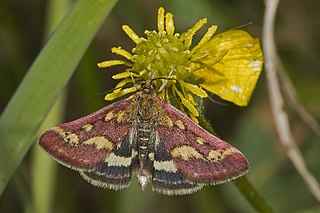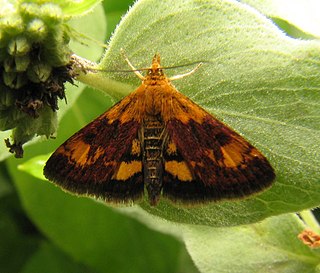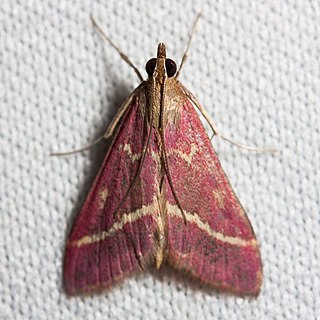
The Crambidae are the grass moth family of lepidopterans. They are variable in appearance, the nominal subfamily Crambinae taking up closely folded postures on grass stems where they are inconspicuous, while other subfamilies include brightly coloured and patterned insects which rest in wing-spread attitudes.

The mint moth is a small moth from the family Crambidae, also known by the common name Small Purple and Gold.
Pyrausta is a mythological insect-sized dragon from Cyprus. It resembles a four-legged insect with filmy wings and a dragon's head. It lived in the fire like a salamander and died if it went away from the fire.

Pyrausta cingulata, the silver-barred sable, is a species of moth of the family Crambidae. It was described by Carl Linnaeus in his 1758 10th edition of Systema Naturae. It is found in Europe.

Pyrausta despicata, the straw-barred pearl, is a species of moth of the family Crambidae. It was described by Giovanni Antonio Scopoli in his 1763 Entomologia Carniolica.

Pyrausta purpuralis is a species of moth of the family Crambidae. It was described by Carl Linnaeus in his 1758 10th edition of Systema Naturae and is found in Europe. The species closely resembles Pyrausta aurata and Pyrausta ostrinalis.

Pyrausta sanguinalis, the scarce crimson and gold, is a moth of the family Crambidae. The species was first described by Carl Linnaeus in his 1767 12th edition of Systema Naturae. It is found across western Europe as far east as southern Finland. In the British Isles it was formerly found at multiple coastal locations in north-west England and Scotland, however it has now much declined and it is restricted to a few locations in Northern Ireland and a single site on the Isle of Man.

Pyrausta ostrinalis, also called the scarce purple and gold, is a species of moth of the family Crambidae. It was described by Jacob Hübner in 1796 and is found in Europe and North Africa.

Pyrausta nigrata is a species of moth of the family Crambidae. It was described by Giovanni Antonio Scopoli in his 1763 Entomologia Carniolica and it is found in Europe.

Pyrausta is a speciose genus of moths of the family Crambidae. The genus was erected by Franz von Paula Schrank in 1802.

Pyrausta orphisalis, the orange mint moth or orange-spotted pyrausta, is a species of moth of the family Crambidae. It was described by Francis Walker in 1859. It is found in North America from Newfoundland west to British Columbia, south to Florida and New Mexico.

Pyrausta aerealis is a species of moth in the family Crambidae described by Jacob Hübner in 1793. It is found in most of Europe. It has also been recorded from Kyrgyzstan, Kazakhstan, Afghanistan, China and Algeria.
Pyrausta limbopunctalis is a species of moth in the family Crambidae. It is found in Portugal, Spain, on Sardinia and in Russia, Turkey and North Africa, including Morocco.
Pyrausta porphyralis is a species of moth in the family Crambidae described by Michael Denis and Ignaz Schiffermüller in 1775. It is found in most of Europe.
Pyrausta insignitalis, the dark-banded pyrausta moth, is a moth in the family Crambidae. It was described by Achille Guenée in 1854. It is found in the United States, where it has been recorded from Florida and South Carolina. It is also found on the West Indies, as well as in Central and South America.

Pyrausta perrubralis is a moth in the family Crambidae. It was described by Packard in 1873. It is found in North America, where it has been recorded from British Columbia, California, New Mexico, Oregon and Washington.
Pyrausta subsequalis is a moth in the family Crambidae. It was described by Achille Guenée in 1854. It is found in North America, where it has been recorded from southern Alberta and southern British Columbia south to Arizona and New Mexico. The habitat consists of dry prairie areas.

Pyrausta tyralis, the coffee-loving pyrausta moth, is a moth in the family Crambidae. It was described by Achille Guenée in 1854. It is found in the United States, where it has been recorded from New York to Illinois and from Florida to Arizona. It is also found from Mexico to Venezuela, as well as on the West Indies.

Pyrausta unifascialis, the one-banded pyrausta, is a moth in the family Crambidae. It was described by Alpheus Spring Packard in 1873. It is found in North America, where it has been recorded from Quebec west to British Columbia, south to Arizona and California. The habitat consists of forest openings, clearings and fields.

Pyrausta volupialis, the volupial pyrausta moth, is a moth in the family Crambidae. It was described by Augustus Radcliffe Grote in 1877. It is found in North America, where it has been recorded from Oklahoma, Utah, Texas, Colorado, New Mexico, Arizona and California to Chiapas, Mexico.













